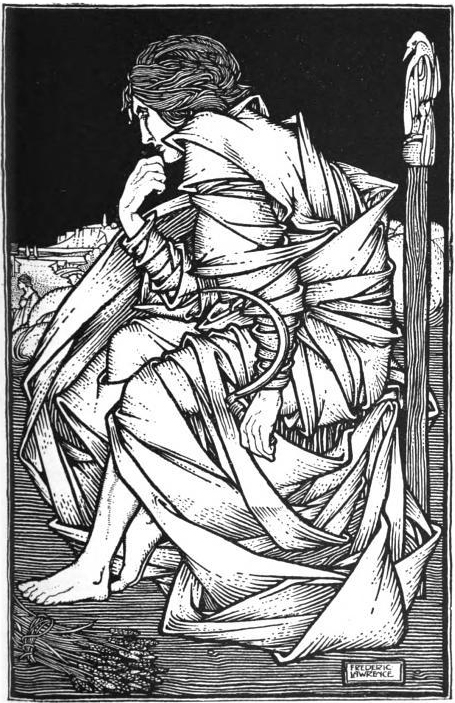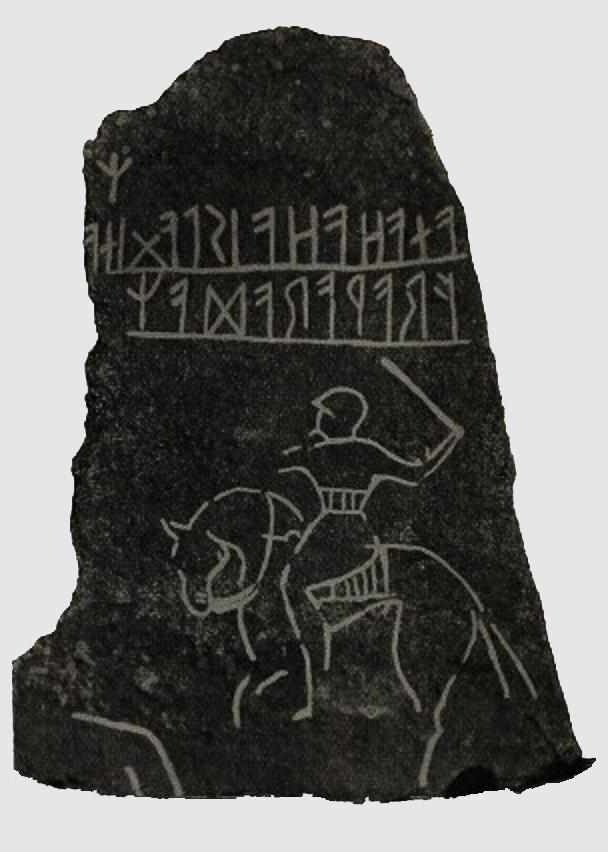|
Klepp I Runestone
The Klepp I Runestone, listed as N 225 in the Rundata catalog, is one of two runestones from Klepp in Rogaland, Norway. It is among the few Viking Age runestones that was raised as a memorial to a woman. Description The Klepp I Runestone has three lines of runic text on two sides of the stone. The runic inscription ends with a cross, indicating that it dates from after the local conversion to Christianity, or the late 10th or early 11th century. The inscription provides an early example of the use of the name ''Kleppr'', which means "rocky hill," for the town of Klepp. It has been suggested that the detailed description of the family relationships in the inscription may have been to document the inheritance of the estate of the deceased woman Ásgerðr. The details of the family ties indicate the different ways that Ásgerðr could inherit property and how it then could be divided among the living. Although the runestone is classified as a Christian monument, Ásgerðr combines two ... [...More Info...] [...Related Items...] OR: [Wikipedia] [Google] [Baidu] |
Rundata
The Scandinavian Runic-text Data Base ( sv, Samnordisk runtextdatabas) is a project involving the creation and maintenance of a database of runic inscriptions. The project's goal is to comprehensively catalog runestones in a machine-readable way for future research. The database is freely available via the Internet with a client program, called Rundata, for Microsoft Windows. For other operating systems, text files are provided or a web browser can be used to interact with the web applicatioRunor History The origin of the Rundata project was a 1986 database of Swedish inscriptions at Uppsala University for use in the Scandinavian Languages Department. At a seminar in 1990 it was proposed to expand the database to cover all Nordic runic inscriptions, but funding for the project was not available until a grant was received in 1992 from the ''Axel och Margaret Ax:son Johnsons'' foundation. The project officially started on January 1, 1993 at Uppsala University. After 1997, the proje ... [...More Info...] [...Related Items...] OR: [Wikipedia] [Google] [Baidu] |
Norse Paganism
Old Norse religion, also known as Norse paganism, is the most common name for a branch of Germanic religion which developed during the Proto-Norse period, when the North Germanic peoples separated into a distinct branch of the Germanic peoples. It was replaced by Christianity and forgotten during the Christianisation of Scandinavia. Scholars reconstruct aspects of North Germanic Religion by historical linguistics, archaeology, toponymy, and records left by North Germanic peoples, such as runic inscriptions in the Younger Futhark, a distinctly North Germanic extension of the runic alphabet. Numerous Old Norse works dated to the 13th-century record Norse mythology, a component of North Germanic religion. Old Norse religion was polytheistic, entailing a belief in various gods and goddesses. These deities in Norse mythology were divided into two groups, the Æsir and the Vanir, who in some sources were said to have engaged in an ancient war until realizing that they were equa ... [...More Info...] [...Related Items...] OR: [Wikipedia] [Google] [Baidu] |
Runestones In Norway
A runestone is typically a raised stone with a runic inscription, but the term can also be applied to inscriptions on boulders and on bedrock. The tradition began in the 4th century and lasted into the 12th century, but most of the runestones date from the late Viking Age. Most runestones are located in Scandinavia, but there are also scattered runestones in locations that were visited by Norsemen during the Viking Age. Runestones are often memorials to dead men. Runestones were usually brightly coloured when erected, though this is no longer evident as the colour has worn off. The vast majority of runestones are found in Sweden. History The tradition of raising stones that had runic inscriptions first appeared in the 4th and 5th century, in Norway and Sweden, and these early runestones were usually placed next to graves. The earliest Danish runestones appeared in the 8th and 9th centuries, and there are about 50 runestones from the Migration Period in Scandinavia. Most runeston ... [...More Info...] [...Related Items...] OR: [Wikipedia] [Google] [Baidu] |
List Of Runestones
There are about 3,000 runestones in Scandinavia (out of a total of about 6,000 runic inscriptions). p. 38. The runestones are unevenly distributed in Scandinavia: The majority is found in Sweden, estimated at between 1,700 and 2,500 (depending on definition). Denmark has 250 runestones, and Norway has 50. There are also runestones in other areas reached by the Viking expansion, especially in the British Isles ( Manx runestones, Page, Raymond I. (1995). Runes and Runic Inscriptions: Collected Essays on Anglo-Saxon and Viking Runes'. Parsons, D. (ed.) Woodbridge: Boydell Press, 207–244 England runestones, Scotland and Ireland) and other islands of the North Atlantic (Faroes, Greenland, but not in Iceland), and scattered examples elsewhere (the Berezan' Runestone in Eastern Europe, Pritsak, O. (1987). ''The Origin of Rus'.'' Cambridge, Mass.: Distributed by Harvard University Press for the Harvard Ukrainian Research Institute. Sawyer, Birgit. (2000). The Viking-Age Rune-Stones ... [...More Info...] [...Related Items...] OR: [Wikipedia] [Google] [Baidu] |
Freyr
Freyr (Old Norse: 'Lord'), sometimes anglicized as Frey, is a widely attested god in Norse mythology, associated with kingship, fertility, peace, and weather. Freyr, sometimes referred to as Yngvi-Freyr, was especially associated with Sweden and seen as an ancestor of the Swedish royal house. According to Adam of Bremen, Freyr was associated with peace and pleasure, and was represented with a phallic statue in the Temple at Uppsala. According to Snorri Sturluson, Freyr was "the most renowned of the æsir", and was venerated for good harvest and peace. In the mythological stories in the Icelandic books the ''Poetic Edda'' and the '' Prose Edda'', Freyr is presented as one of the Vanir, the son of the god Njörðr and his sister-wife, as well as the twin brother of the goddess Freyja. The gods gave him Álfheimr, the realm of the Elves, as a teething present. He rides the shining dwarf-made boar Gullinbursti and possesses the ship Skíðblaðnir which always has a favorab ... [...More Info...] [...Related Items...] OR: [Wikipedia] [Google] [Baidu] |
Gerðr
In Norse mythology, Gerðr (Old Norse: ; "fenced-in"Orchard (1997:54).) is a jötunn, goddess, and the wife of the god Freyr. Gerðr is attested in the ''Poetic Edda'', compiled in the 13th century from earlier traditional sources; the '' Prose Edda'' and ''Heimskringla'', written in the 13th century by Snorri Sturluson; and in the poetry of skalds. ''Gerðr'' is sometimes modernly anglicized as Gerd or Gerth. In both the ''Poetic Edda'' and the ''Prose Edda'', Freyr sees Gerðr from a distance, becomes deeply lovesick at the sight of her shimmering beauty, and has his servant Skírnir go to Jötunheimr (where Gerðr and her father Gymir reside) to gain her love. In the ''Poetic Edda'' Gerðr initially refuses, yet after a series of threats by Skírnir she is forced to yield. In the ''Prose Edda'', no mention of threats is made. In both sources, Gerðr agrees to meet Freyr at a fixed time at the location of Barri and, after Skírnir returns with Gerðr's response, Freyr laments ... [...More Info...] [...Related Items...] OR: [Wikipedia] [Google] [Baidu] |
Æsir
The Æsir (Old Norse: ) are the gods of the principal pantheon in Norse religion. They include Odin, Frigg, Höðr, Thor, and Baldr. The second Norse pantheon is the Vanir. In Norse mythology, the two pantheons wage war against each other, resulting in a unified pantheon. Unlike the Old English word ''god'' (and the Old Norse word '), Æsir was never converted over to Christian use. Etymology ''Æsir'' is the plural of '' áss'', ''ǫ́ss'' "god". In genitival compounds, it takes the form ', e.g. in ' ("Thor of the Æsir"), besides ' found in : '' ás-brú'' "gods' bridge" (the rainbow), : ' "gods' enclosure", : ' "gods' kin", : ' "gods' leader", : ' "gods' might" (especially of Thor), : ' "divine wrath" etc. : ' "national god" (') is a title of Thor, as is : ' "almighty god", while it is Odin who is "the" '. There is also Old East Norse dialectal : *''ās-ækia'' (OWN: *''áss-ekja''), i.e. "god ride" (Thor riding in his wagon), resulting in the modern Swedish word ... [...More Info...] [...Related Items...] OR: [Wikipedia] [Google] [Baidu] |
Inheritance
Inheritance is the practice of receiving private property, titles, debts, entitlements, privileges, rights, and obligations upon the death of an individual. The rules of inheritance differ among societies and have changed over time. Officially bequeathing private property and/or debts can be performed by a testator via will, as attested by a notary or by other lawful means. Terminology In law, an ''heir'' is a person who is entitled to receive a share of the deceased's (the person who died) property, subject to the rules of inheritance in the jurisdiction of which the deceased was a citizen or where the deceased (decedent) died or owned property at the time of death. The inheritance may be either under the terms of a will or by intestate laws if the deceased had no will. However, the will must comply with the laws of the jurisdiction at the time it was created or it will be declared invalid (for example, some states do not recognise handwritten wills as valid, or on ... [...More Info...] [...Related Items...] OR: [Wikipedia] [Google] [Baidu] |
Runestone
A runestone is typically a raised stone with a runic inscription, but the term can also be applied to inscriptions on boulders and on bedrock. The tradition began in the 4th century and lasted into the 12th century, but most of the runestones date from the late Viking Age. Most runestones are located in Scandinavia, but there are also scattered runestones in locations that were visited by Norsemen during the Viking Age. Runestones are often memorials to dead men. Runestones were usually brightly coloured when erected, though this is no longer evident as the colour has worn off. The vast majority of runestones are found in Sweden. History The tradition of raising stones that had runic inscriptions first appeared in the 4th and 5th century, in Norway and Sweden, and these early runestones were usually placed next to graves. The earliest Danish runestones appeared in the 8th and 9th centuries, and there are about 50 runestones from the Migration Period in Scandinavia. Most runeston ... [...More Info...] [...Related Items...] OR: [Wikipedia] [Google] [Baidu] |
Christianity
Christianity is an Abrahamic monotheistic religion based on the life and teachings of Jesus of Nazareth Jesus, likely from he, יֵשׁוּעַ, translit=Yēšūaʿ, label=Hebrew/Aramaic ( AD 30 or 33), also referred to as Jesus Christ or Jesus of Nazareth (among other names and titles), was a first-century Jewish preacher and religious .... It is the Major religious groups, world's largest and most widespread religion with roughly 2.38 billion followers representing one-third of the global population. Its adherents, known as Christians, are estimated to make up a majority of the population in Christianity by country, 157 countries and territories, and believe that Jesus in Christianity, Jesus is the Son of God (Christianity), Son of God, whose coming as the Messiah#Christianity, messiah was Old Testament messianic prophecies quoted in the New Testament, prophesied in the Hebrew Bible (called the Old Testament in Christianity) and chronicled in the New Testamen ... [...More Info...] [...Related Items...] OR: [Wikipedia] [Google] [Baidu] |



